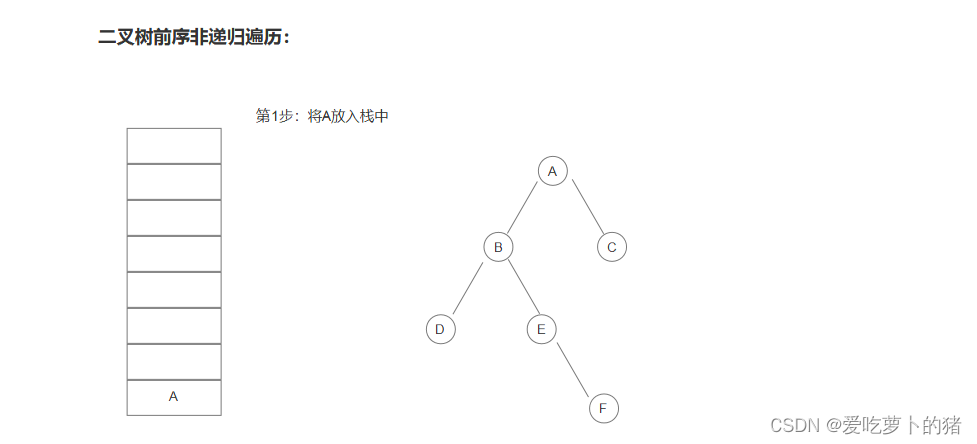一.前序非递归遍历
1.前序非递归遍历原理
二叉树的非递归遍历需要借助栈来实现,将根节点压栈,再出栈顶元素,再将这个元素的左右孩子压栈(次序,右孩子先进入,左孩子后进入),重复上述操作,直至遍历结束。
2.图解







3.代码实现
定义栈结构,操作:
//链栈结构
typedef struct SNode {
struct TNode * node;
struct SNode* next;
}*LinkStack,StackNode;
//初始化
bool initStack(LinkStack &S) {
S = NULL;
return true;
}
//进栈
bool Push(LinkStack& S,TNode* e) {
StackNode* q=(StackNode*)malloc(sizeof(StackNode));
if (q == NULL) {
return false;
}
q->node = e;
q->next = S;
S = q;
return true;
}
//出栈
bool Pop(LinkStack& S,TNode* &e) {
//这里判空是防止传过来的栈是一个空栈
if (S == NULL) {
return false;
}
StackNode* p;
p = S;
e = S->node;
S = S->next;
free(p);
return true;
}
//判断栈空
bool isEmpty(LinkStack S) {
if (S == NULL) {
return true;
}
else
return false;
}定义二叉树结构及操作:
//二叉树链式结构
typedef struct TNode {
ElemType data;
struct TNode* lchild, * rchild;
}*BitTree,TNode;
//创建二叉树
BitTree CreateTree(BitTree &T) {
ElemType data;
scanf("%c", &data); // 输入数据
ElemType bufCh;
bufCh = getchar(); // 消除上面输入字符回车后,存在缓冲区的 '\n'
if (data == '#') { // 输入# 代表此节点下子树为NULL
return NULL;
}
else {
T = (BitTree)malloc(sizeof(TNode)); // 创建结点
if (!T) {
printf("%s\n", strerror(errno));
return NULL;
}
T->data = data;
printf("请输入%c的左子树: ", data);
T->lchild = CreateTree(T->lchild); // 递归创建左子树
printf("请输入%c的右子树: ", data);
T->rchild = CreateTree(T->rchild); // 开始到上一级节点的右边递归创建左右子树
return T; // 返回根节点
}
}
非递归前序遍历代码实现
:
bool PreOrderNoneRecusTraerse(BitTree &T) {
LinkStack S;
initStack(S);
TNode* popEle;
Push(S, T);
int count = 0;
//利用栈进行遍历
while (!isEmpty(S)) {
Pop(S, popEle); //栈顶元素出栈
printf("%c ", popEle->data);
if (popEle->rchild != NULL)
Push(S, popEle->rchild); //右孩子入栈
if (popEle->lchild != NULL)
Push(S, popEle->lchild); //左孩子出栈
}
return true;
}
测试:

版权声明:本文为qq_51950769原创文章,遵循 CC 4.0 BY-SA 版权协议,转载请附上原文出处链接和本声明。